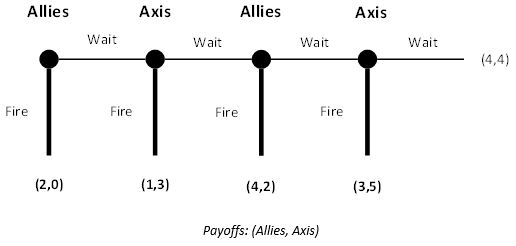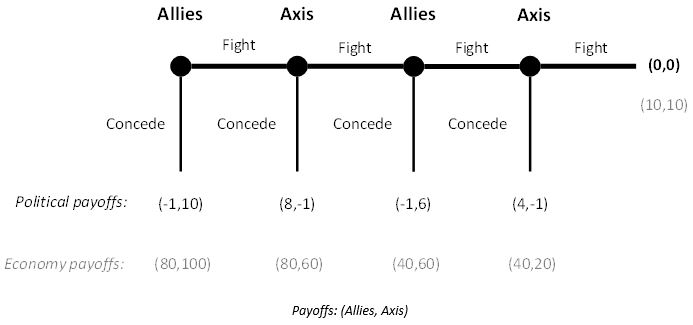
Is it better to cut your losses now, or prolong the game in hopes of a better result? Game theory tells us that structure and payoffs matter when it comes to the duration of games. Games of preemption, for example, tend to terminate in impatience, while games of attrition are often protracted affairs.
Game of preemption
In games of preemption, players must choose between ending or continuing the game. While continuing the game generates jointly higher benefits, the player that ends the game captures a privately higher payoff. While there are benefits to prolonging the game, the player’s incentive to pre-empt their opponent typically results in early termination.
Nuclear war
Let’s consider, for example, a sequential game of cold war between the Axis and Allies. Each coalition must decide between Fire (launching of nukes) and Wait (preservation of peace). In this simplified world, the advantage goes to the coalition that strikes first. Waiting, however, confers benefits in the form of peace and international trade to both sides. The decision tree below, read from left to right, summarises the players, move orders, and payoffs associated with this game:
Game of preemption

Subgame perfect Nash equilibrium
The subgame perfect Nash equilibrium (SPNE) of this game sees both players choosing Fire at every turn. The payoffs associated with this SPNE, of course, is 2 to the first mover (Allies), and zero to the second mover (Axis). We can use backward induction to see why. At the last subgame, the Axis would choose fire (payoff of 5) over wait (payoff of 4). Knowing this, the Allies chooses fire in the subgame before. Anticipating this, the Axis chooses fire in the preceding subgame. Foreseeing this, the Allies then chooses fire on the very first turn. Indeed, because the temptation to fire pre-emptively is strong, the game ends right away. In turn, both the Axis and Allies miss out on the jointly better payoff of 4 from waiting until the very end.
Game of attrition
In games of attrition, players choose between ending or continuing the game. Unlike games of pre-emption, however, prolonging the game leads to inferior collective payoffs. Unfortunately, the player that ends the game invokes a high personal cost. So, each player, in hopes the other terminates first, drags the game out. This, in turn, degenerates into a game of extended inaction or protraction.
Proxy war
To see this, let’s return to our game of war. This time, the Allies and Axis engage in a proxy war with an additional wrinkle – we distinguish between political payoffs (payoffs to the decision maker) and economic payoffs (benefits to the nation). In this game, politicians must choose between Concede (surrender with reparations) or Fight (prolong the war). An extended war is, of course, undesirable to both nations. But the reputational damage from conceding is equivalent to political suicide. The decision tree below summarises the players, move orders, and payoffs associated with this game:
Game of attrition

Subgame perfect Nash equilibrium
The SPNE strategic profile of this game sees politicians from both coalitions choosing Fight at every turn. The political payoffs associated with this SPNE is zero to the politicians on both sides. To see why, notice that at the very last subgame, the Axis prefers to fight (payoff of zero) than to concede (payoff of -1). Anticipating this, the Allies also prefer to fight than to concede in the second last subgame. Of course, the Axis knows this, and prefers to fight in the preceding subgame. And by process of backward induction, we arrive at the first subgame, in which the Allies’ best response is to fight once again.
Principal agent problem
The result of this SPNE is, of course, disastrous to both economies. The payoff of 10 to both economies is the worst of all possible outcomes in this game of attrition. This specific game is also an example of the principal-agent problem, where a misalignment of incentives between the politicians (agent) and their nations (principal) results in a conflict of interest.
What game are we playing?
The results above may give the impression that war is inescapable. But what if the Allies and Axis had access to second strike capability in the game of pre-emption? The ability to retaliate might alter the payoffs, calculations, and incentives for pre-emption. Indeed, misspecification or omission of key details can harm our conclusions. We have to diagnose the strategic situation with utmost care.
Even then, players are not compelled to participate in the game at hand. Remember that strategy also involves transforming the game to one’s advantage. For example, you might’ve noticed that in our game of attrition, the combined political payoff on the first turn (9) is higher than the combined payoff associated with the SPNE (zero). If this game was transformable, politicians on both sides might share an incentive to negotiate a cease fire, split the political brownie points, and avoid prolonging the proxy war any further.
Do people use backward induction?
Note also that the subgame perfect Nash equilibrium solution concept rests on the assumption of common rationality. That is, all players are rational, and know that everybody else is rational too. By way of backward induction, they can formulate beliefs about others’ best responses, their best response, their adversary’s best response to their best response, and so on.
In practice, however, people don’t always reason this way. We often see business executives, for example, make pricing and product decisions in isolation of competitor responses. Decision trees, backward induction, and Nash equilibrium concepts offer only a starting point. You have to truly understand the options, players, and payoffs, to anticipate what will happen and what to do.
Further reading
- Sequential games and subgame perfect Nash equilibrium
- First mover and second mover advantage — Games of hares and tortoises
- Commitments, threats, and promises — Tools to deter and compel
- Brinkmanship and the manipulation of shared risk